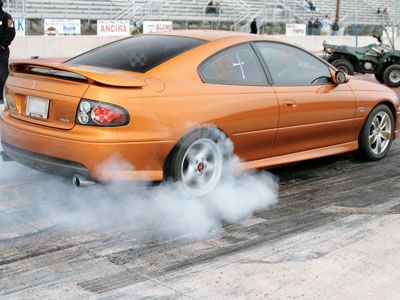
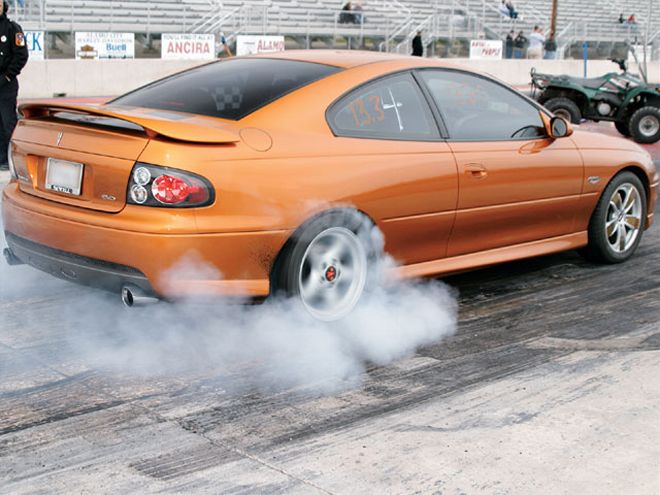
Don't fear. When the dense smoke finally dissipates, the second part of the Mickey Thompson ET Street Tire install and test will magically appear, transporting you to a time and place filled with the intoxicating sights, sounds and smells of Pontiac performance, the hallowed shrine known world-wide as the dragstrip.
Whether powered via an LS1 or LS2 motor, it doesn't take long to obliterate the stock tires on a Firebird or GTO, especially when you are driving aggressively or trying to maximize performance on the track. For late-model GTO owners, the diminutive size of the 245/45ZR17 tires further exacerbates obtaining maximum traction as a result of the OEM design of the rear wheelwells.
In Part I, we showed you how to put a large, super-sticky drag radial tire under a late-model GTO without "rolling" the inner fender and potentially reducing the collector value of your Pontiac. To accomplish this, we mounted M/T ET Street Radial tires in a 275/40-17 size ($189 each) onto a set of used 17x9 WS6 wheels ($200 for the set) and machined them ($75) for safety purposes. A set of BMR's GTO drag bags ($99.95) were then installed to allow the rear suspension dampening to be modified, providing adequate tire clearance on the '06 GTO owned by Bob Cook from Allen, Texas.
In order to test the merits of the M/T ET Street tires vs. stock tires, we brought out the nearly stock subject automatic-equipped '06 GTO and the author's own modified 6-speed '00 Formula WS6. As you may recall from previous articles, this rare Bird was transformed into a fire-breathing monster with the addition of an STS rear-mounted turbo.
2000 Formula Tire Test Results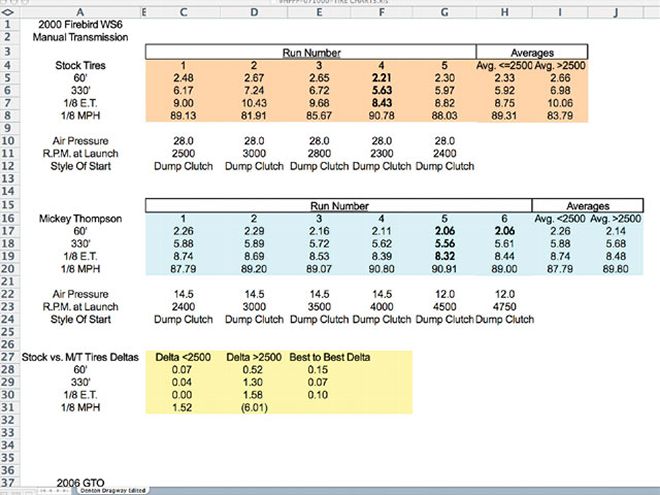 <STRONG>2000 Formula Tire Test Results</STRONG><BR>Stock Tires: Yokohama Avs Es100, 275/40/Zr17<BR>Aftermarket Tires: M/T Et Street Radials 275/40/R17, R2 Compound
<STRONG>2000 Formula Tire Test Results</STRONG><BR>Stock Tires: Yokohama Avs Es100, 275/40/Zr17<BR>Aftermarket Tires: M/T Et Street Radials 275/40/R17, R2 Compound
When the smoke clears and the tires are tested to within mere inches of their lives, will the on-track prowess of the M/T tires for stock and modified late-model Pontiac applications be revealed?
Strip Testing
Testing was conducted on a warm spring day at Texas Raceway in Kennedale, Texas, a modern 1/8-mile racing venue in the Dallas-Fort Worth area. Temperatures varied between 68 and 74 degrees with partly sunny skies, light winds between 6-10 mph and humidity of 54 percent. The Texas Muscle Car Club Challenge Series was holding the first race of 2007 and the organizers, along with Texas Raceway, graciously allowed HPP to conduct tire-testing between rounds of the event.
Rather than simply launching at a pre-set rpm on both cars and documenting the 60-foot time differences, it was determined that it was necessary to establish an rpm threshold to find out when the stock tires would start spinning, thereby reducing performance.
To that end, both sets of stock tires were set to 28 psi by using the same gauge and were tested at various rpm in order to find out where they would get "blown-off." Once the baseline was established for the adhesion limits of the stock tires, the strategy for testing the M/T tires was to launch at or around the rpm where the stock tires would spin. Then the rpm was raised to find out how much additional power the drag radials could hold before spinning themselves.
Tire pressure was varied between 12 and 18 psi for the testing of the M/Ts to account for differences in weight between the two cars and to find out if the tires performed better at higher or lower pressures.
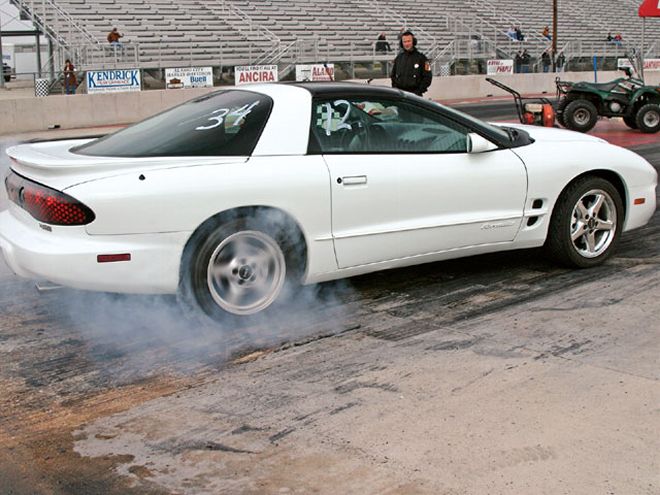
2000 Formula WS6 Tire Test
The '00 Formula WS6 was relatively light, weighing in at 3,242 pounds with a half-tank of gas. Equipped with an STS rear-turbocharger, the LS1-based Formula had 392.4 rear-wheel horsepower and 409.3 lb-ft of torque on tap at the tested boost pressure of 5.0 psi. Shifting was done via a stock T56 manual transmission, and the clutch was previously upgraded with an Exedy Twin-Disc unit to withstand the added power levels. The 10-bolt rear end was beefed-up with aftermarket axles and an Eaton Posi unit (HPP, Nov. '06).
Unlike OEM-style clutches, a twin-disc clutch is not designed to be slipped to modulate power coming out of the hole. Its intended purpose is to provide firm, positive clutch engagement and to withstand high-rpm launches.
With the stock tires, the Formula bogged on launch at an rpm of 2,300 or less. Since a bog off of the line increases 60-foot times, the rpm was raised to 2,400, whereby the tires started to spin and 60-foot times degraded further. Unfortunately, without the ability to "slip" the clutch, finding the exact rpm that doesn't produce a bog or spin is elusive. As rpm was increased at launch to 2,500 or greater, the tire spin intensified. Once the spin worsened, the tires heated up, resulting in the Formula walking from side to side on every shift, leading to poor 1/8-mile times.
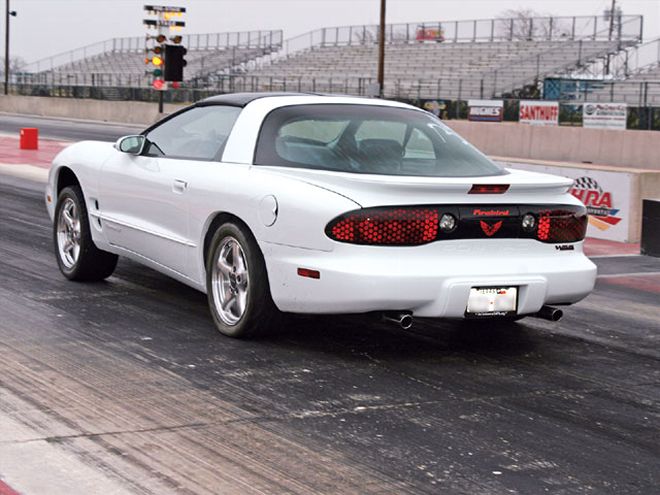
When the stock tire-testing concluded, the best 60-foot time that could be mustered was a 2.21, coming out at 2,300 rpm with an 8.43 1/8-mile time. On the other end of the spectrum, a 3,000 rpm launch roasted the tires, resulting in an abysmal 2.67 short time with a horrid 10.43 1/8-mile time.
After switching to the M/T tires and setting the air pressure to 14.5 psi, the Bird was launched at the optimal rpm for the stock tires (2,300), which resulted in a 2.26 60-foot time. Right away it was apparent that the Mickey Thompson tires were getting more traction as the bog coming off of the starting line was significantly worse. In order to compensate for the bog, the rpm was increased all the way up to 3,000, whereas the stock tires produced their worst 60-foot time at 3,000 rpm. The M/T tires put down a 2.29 60-foot time. Although not as fast as the best stock run, the results were encouraging.
As launch rpm was increased, the 60-foot times came down. After determining that the 60-foot times steadily improved through 4,000 rpm launches, the tire pressure was reduced to 12 pounds to see if traction could be further improved. Simultaneously, the launch rpm was increased to 4,500. Not only did the M/T tires like the lower tire pressures, but the more power that was put to them, the better they hooked. With a 2.06 60-foot time logged from a 4,500 rpm launch, the Formula was driven straight back to the staging lanes, where the rpm was raised to 4,750 and the clutch was dumped yet again. With a second consecutive 2.06 60-foot time as a result, and the test session winding down, the 60-foot times were on a steady march downward.
Since any further elevation of the launch rpm would have resulted in an almost instant-aneous shift to Second gear, there was no reason to increase the launch rpm. Given the power of the car and the taut WS6 suspension, the results were impressive, especially since the Bird would no longer get "loose" on each gear shift. Since the Formula is turbocharged, by launching at a higher rpm, the car was able to get into the boost quicker and produce more power. The tires absorbed the extra power leading to reduced 60-foot times and the quickest (8.32) 1/8-mile time of the day. See the chart for the full breakdown.
2006 GTO Tire Test
The 2006 automatic-equipped GTO weighed in at 3,725 pounds with a half-tank of gas. The car is stock, other than a custom dyno tune by Real Performance Motorsports that bumped output up by 20.1 rwhp, while simultaneously deleting the performance robbing torque management (HPP, July '07). With 322.8 rwhp and 323.7 lb-ft of torque on tap, the 364 cubic inch LS2 GTO, equipped with an SLP Brake-Control Package, was able to raise the rpm enough on launch to find the limits of the stock tires.
After driving the M/T ET Street tires on the road with the BMR drag bags set at 10 psi, it was quickly discovered that if the car was launched hard on a sticky surface, the inner fender lip would come in contact with the tire. As a result, the air pressure was raised to 22 psi. For drag testing, the bags were set at 24 psi, since a prepped track should theoretically have more traction than the local streets
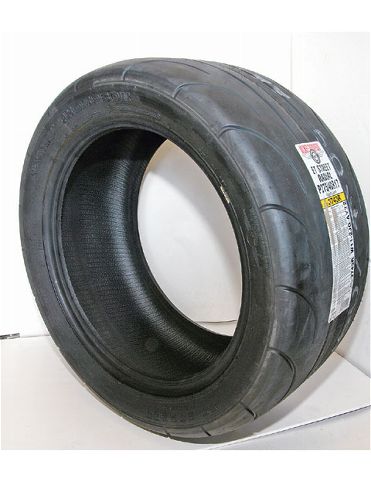 M/T's 275/40R17 ET Street Radial (Part No. 3743R) is a DOT approved street legal drag radial optimized for dry traction. It is not recommended for use in the rain. The company recommends an 8-10-inch wide rim, tire pressures of 12-16 psi and a short burnout to activate the sticky R2 compound of the tires.
M/T's 275/40R17 ET Street Radial (Part No. 3743R) is a DOT approved street legal drag radial optimized for dry traction. It is not recommended for use in the rain. The company recommends an 8-10-inch wide rim, tire pressures of 12-16 psi and a short burnout to activate the sticky R2 compound of the tires.
With the stock tires, the GTO was initially tested utilizing the Brake-Control Package at a starting rpm of 1,500. Right off the bat, the car pulled its best 60-foot times of the stock tire test with a 2.17 and an 8.98 1/8-mile time. On the very next run, the Goat was launched at 2,000 rpm, resulting in the stock tires spinning and a poor 60-foot time of 2.32. A second launch at 2,000 rpm produced even worse results, letting it be known that the rpm had to be below 2,000 in order for the stock tires to have any chance of maintaining traction.
To verify that the stock tires could handle the low rpm launches, the GTO was launched at 1,200 rpm on the footbrake. Instantly, the 60-foot times dropped dramatically and the run ended up being almost identical to the first run (1,500 rpm launch) with a 9.00 1/8-mile time.
Having isolated that the stock tires spun badly at 2,000 rpm, the focus turned to determining where within the 1,500 to 2,000 rpm band that spin became excessive. Since the GTO's tach-ometer is not broken down into 100 rpm increments, it was difficult to accurately gauge the precise launch point. Two launches at 1,800 rpm produced almost identical 60-foot times to the earlier 2,000 rpm launches. Any launch above 1,500 rpm produced wheel spin and poor performance.
Since the GTO was a bit heavier than the Formula, and likely heavier than the average car utilizing these tires, the initial air pressure setting for the M/T tires was 18 psi. Launching at 1,500 rpm, the first run produced the fastest 60-foot and quickest 1/8-mile e.t. With a 2.14 60-foot and an 8.91 1/8-mile, the M/T tires were already performing better than their stock counterparts.
After a second pass at 1,500 rpm to see how the GTO would perform when warmer, an 1,800 rpm launch netted a 2.24 60-foot time. Although not as quick as the 1,500 rpm launch earlier, it was over a tenth better than the best recorded 1,800 rpm launch on the stock tires (2.36). Since there was no clear indication that the M/T tires were spinning, we adjusted the air pressure to see how the tires would respond.
At 15 psi, the Goat was launched at 1,500 rpm. Unfortunately, the tires didn't respond as expected and the 60-foot times decreased to 2.30. Although spin wasn't evident, the Pontiac seemed to labor coming out of the hole, resulting in one of its poorer 1/8-mile times. With the racing session nearing completion, a decision had to be made on whether to increase the tire pressure or maintain it and perform one final 2,000 rpm launch. The tire pressure was maintained and the higher rpm launch resulted in a 60-foot time reduction to 2.26 with only a marginal improvement in the 1/8-mile e.t.
At the conclusion of the test session, it was evident that above 1,500 rpm, the M/T tires would achieve better traction and never be completely "blown-off" like the stock tires.
Conclusion
Both the Yokohama AVS ES100 tires utilized on the Formula and the BFGoodrich G-Force KDW's fitted on the GTO were relatively new with well under 7,500 miles and only slight tread wear. Although both are top name brand performance tires, it didn't take long to find out where the limits of traction were when subjected to higher rpm launches.
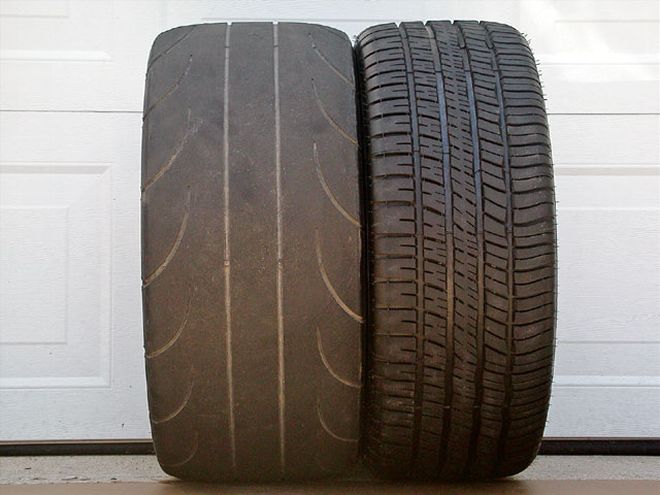 A comparison between the stock 17x8-inch 5-spoke GTO rims shod with a P245/45ZR17 BFGoodrich G-Force TA KDW tire (on the right), versus the 17x9-inch WS6 rim with a 275/40/R17 M/T ET Street radial is telling. Although the stock tire diameter on the GTO rim is identical to the WS6/M/T combination (26.0-inches), the mounted tread width of the stock wheel/tire combination, as stated by the manufacturers (as measured from corner to corner), is 9.65 inches (BFG) versus 10.0 inches (M/T). The actual contact patch is measured at 8.5 and 10.5 respectively, giving the M/T tire a true two-inch advantage.
A comparison between the stock 17x8-inch 5-spoke GTO rims shod with a P245/45ZR17 BFGoodrich G-Force TA KDW tire (on the right), versus the 17x9-inch WS6 rim with a 275/40/R17 M/T ET Street radial is telling. Although the stock tire diameter on the GTO rim is identical to the WS6/M/T combination (26.0-inches), the mounted tread width of the stock wheel/tire combination, as stated by the manufacturers (as measured from corner to corner), is 9.65 inches (BFG) versus 10.0 inches (M/T). The actual contact patch is measured at 8.5 and 10.5 respectively, giving the M/T tire a true two-inch advantage.
With a manual transmission and explosive power on tap, the Formula would spin the stock tires badly at 2,400 rpm or greater and then lose traction down the track, resulting in poor performance. With the M/T ET Street Radials mounted on the Formula, we never did find an elevated rpm that would spin the tires badly. In addition to averaging over 0.5 seconds better at 2,500 rpm or greater, the tire performance consistently increased in direct correlation to the engine rpm increase.
The GTO quickly found the breaking point of the stock rubber to be 1,500 rpm or greater. The Brake-Control Package wasn't used exclusively, because with the stock tires and the package enabled at elevated rpm, the stock torque converter would begin to rotate the rear tires on the starting line. Since the converter seemed to have stock stall speed just above 1,800 rpm, higher rpm launches that the M/T tires liked on the Formula were not possible with the GTO.
Although the M/T tires showed a 0.1 average gain when launched at 1,500 rpm or greater, it is quite possible the gain would have been more if the tire pressure hadn't have been reduced. Evidence of this is provided by Bob Cook who stated, "After bracket-racing the car in events following this test, the M/T tires responded better by elevating the tire pressure back to 18 psi. A whole string of low 2.0 60-foot times with a best 60-foot of 2.02 convinced me that the tires are very consistent performers."
As noted, the air pressure in the BMR drag bags was not changed after being set to 24 psi. Since the drag bags have the ability to modulate the rate of dampening, it would have been beneficial to have an additional test session to find the perfect combination of tire and drag bag pressure to optimize performance. However, it must be noted that all these tests take a great deal of time and they must be performed on the same day to ensure consistent weather and track surface.
When all of the testing concluded at the strip, two things were very clear. One, the M/T tires did indeed improve 60-foot times and two, the more power that you can throw at them, the greater the advantage they will provide in the way of increased performance and safety at the strip. According to Cook, "although the Mickey Thompson tires didn't produce huge gains in 60-foot times at my current power level, I am confident that the tires will produce bigger benefits as the engine power increases and a higher stall converter is employed."
For enthusiasts looking for a super-sticky drag radial that will dramatically decrease 60-foot times at elevated launch rpm and horsepower levels, the M/T tires are an excellent choice. If your late-model ride doesn't quite have 11-second potential, the M/T tires will benefit you by allowing more consistent launches and by preparing your Pontiac for the next level of mods. After all, with dozens of 9-second F-bodies choosing M/T ET Street Radials over traditional drag slicks, it's a clear indication that the tires perform.
SLP Brake-Control Package
In order to produce more consistent burnouts or to hold a manual transmission car from rolling though the staging lights, SLP's Brake-Control Package is a great addition for any high-performance Pontiac headed to the strip. The package employs an electric solenoid that, when switched while holding down the brake pedal, keeps the front brakes engaged after the pedal is released and until the switch is released.
For the tire testing on the '06 GTO, an SLP Brake-Control Package was installed, which allowed the owner to perform the recommended burnouts on the M/T tires and as an aid in elevating the launch rpm.
Although utilizing this package as a poor-man's transbrake isn't its intended purpose, it will allow an automatic-equipped car to load the converter up to the point that the rear tires begin to lose traction and start spinning at the starting line. R.A.
Supplies Required:
Brake fluid
Drill and drill bits
Flare wrenches
Motive Power Bleeder (brake bleeder)
Metric socket set
Metric wrenches
Tire pressure gauge